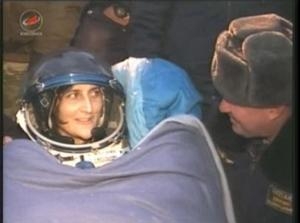First Pre-Dawn Landing In The Dark For A Station Crew In Six Years
Three members of the Expedition 33 crew undocked from the International Space Station and returned safely to Earth Sunday, wrapping up a mission lasting more than four months. Expedition 33 Commander Sunita Williams of NASA, Flight Engineer Akihiko Hoshide of the Japan Aerospace Exploration Agency and Russian Soyuz Commander Yuri Malenchenko undocked their Soyuz TMA-05M spacecraft from the space station at 1726 EST and landed north of Arkalyk, Kazakhstan, at 2056 EST ... or 0756, November 19, Kazakhstan time. The trio arrived at the station July 17 and spent 127 days in space, 125 of which were aboard the orbiting laboratory. This was the first pre-dawn landing in darkness for a station crew since April 9, 2006, when Expedition 12 crew members returned.

NASA astronaut Kevin Ford took command of the space station on Nov. 18. When the Soyuz spacecraft undocked from the space station, Expedition 34 began. Ford and his crewmates, Russian cosmonauts Oleg Novitskiy and Evgeny Tarelkin, will tend to the station as a three-man crew for one month until the arrival of three new crew members, including NASA astronaut Tom Marshburn.
Expedition 33 advanced the scope of research aboard the station by conducting a wide range of physical science, Earth observation and technology demonstration investigations. Research included testing radiation levels on the orbiting outpost, assessing how microgravity affects the spinal cord, and investigating dynamic processes on Earth, such as melting glaciers, seasonal changes and human impacts on the ecosystem.
The crew also participated in the Integrated Resistance and Aerobic Training Study-Sprint, which evaluates the use of high-intensity, low-volume exercise training to minimize loss of muscle, bone and cardiovascular functions during long-duration missions. The expedition also managed a number of visits by international and commercial spacecraft, including the first contracted commercial resupply flight by SpaceX, and conducted several challenging spacewalks to sustain the productive operation of the orbiting complex.
Williams, Hoshide and Malenchenko orbited Earth 2,032 times and traveled 54,090,628 miles. Williams, who has spent 322 days in space on two missions, now ranks sixth on the all-time U.S. endurance list, and second all-time for a female. Malenchenko has spent 642 days in space on his five flights, which ranks him seventh on the all-time endurance list. During their mission, Williams and Hoshide performed three spacewalks to replace a component that relays power from the space station's solar arrays to its systems and repair an ammonia leak on a station radiator. With 50 hours and 40 minutes, Williams holds the record for total cumulative spacewalk time by a female astronaut. Hoshide holds the record for total cumulative spacewalk time by a JAXA astronaut at 21 hours and 23 minutes.
(Pictured: Expedition 33 Commander Sunita Williams following landing. NASA TV Image)
 ANN's Daily Aero-Linx (05.02.24)
ANN's Daily Aero-Linx (05.02.24) ANN's Daily Aero-Term (05.02.24): Touchdown Zone Lighting
ANN's Daily Aero-Term (05.02.24): Touchdown Zone Lighting Aero-News: Quote of the Day (05.02.24)
Aero-News: Quote of the Day (05.02.24) ANN FAQ: Contributing To Aero-TV
ANN FAQ: Contributing To Aero-TV NTSB Final Report: Cirrus Design Corp SR20
NTSB Final Report: Cirrus Design Corp SR20



